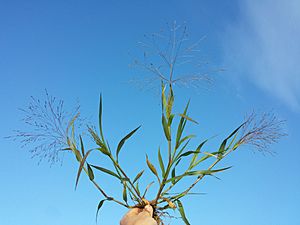Hillmann's panicgrass facts for kids
Quick facts for kids Hillmann's panicgrass |
|
|---|---|
 |
|
| Scientific classification | |
| Genus: |
Panicum
|
| Species: |
hillmanii
|
Panicum hillmanii, also known as Hillmann's panicgrass, is a type of grass. It belongs to the Panicum group of grasses. This plant originally comes from the Southwestern United States.
Over time, Hillmann's panicgrass has spread to many other places. It is now common in southern Australia. You can also find it in some parts of Europe.
What is Hillmann's Panicgrass?
Hillmann's panicgrass is a grass that lives for many years. This means it doesn't die after one growing season. It looks a lot like another grass called Hairy Panic.
You can tell Hillmann's panicgrass apart by a few things. Its seed heads, called panicles, are a bit stiffer. The leaves are also firmer. It has special parts on its flowers, like a developed palea and a larger, darker fertile lemma. The lemma can be up to 2mm long and has a clear crescent shape at its base.
Where Does Hillmann's Panicgrass Grow?
Hillmann's panicgrass is native to the Southwestern United States. This is where it naturally grew for a long time.
It was brought to Australia in the early 1900s. Since then, it has spread across many Australian states. These include South Australia, Victoria, New South Wales, and Tasmania. It often grows alongside a native grass called Witchgrass.
This grass has also been found in Europe. It's been seen in countries like France, Belgium, Austria, and Germany. In Europe, it's not as common. It mostly grows as a weed in corn fields or along roadsides.
Interesting Facts About Hillmann's Panicgrass
Like some other Panicum grasses, Hillmann's panicgrass can become a tumbleweed. This happens when conditions are very dry. The plant breaks off at the base and rolls away in the wind.
When many dry grass stalks gather, they can be a fire risk. This is especially true in neighborhoods. Farmers also need to be careful with this grass. It contains natural substances called saponins. These can cause health problems for animals that eat too much of it.


